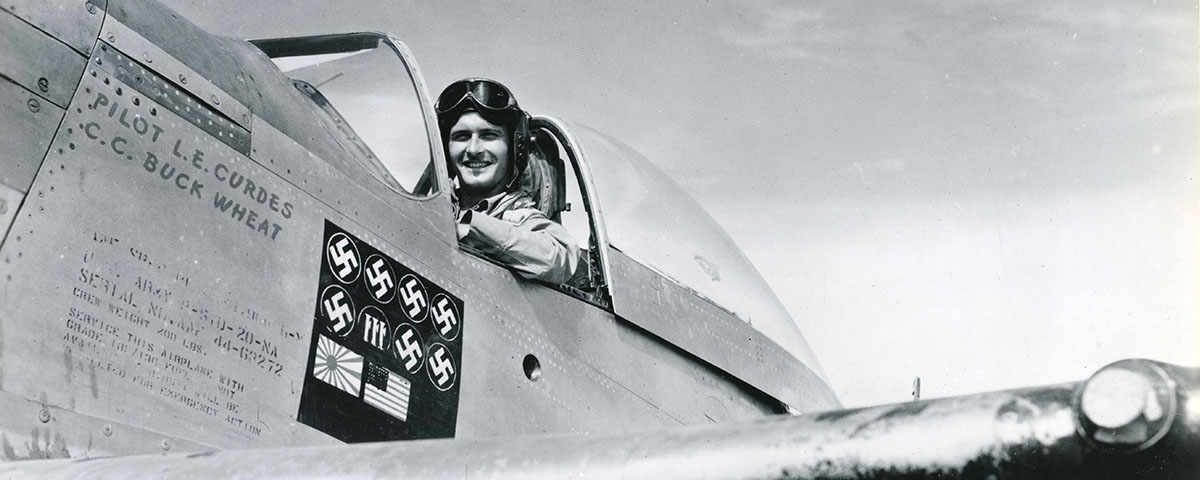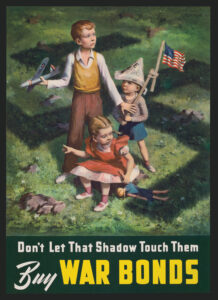American Louis Curdes shot down German, Italian and Japanese airplanes, then added a U.S. transport to his tally
And just one, Louis Curdes, scored an Axis trifecta plus an American plane to boot. Curdes’ unusual story has gone viral online, where it was embellished with distortions and half-truths. Here are the facts.
In late April 1943, 2nd Lt. Louis E. Curdes of Ft. Wayne, Ind., flew his first mission in a Lockheed P-38G Lightning for the 95th Fighter Squadron, 82nd Fighter Group. Over Cap Bon, Tunisia, his flight ran into a group of Messerschmitt Me-109s. Curdes got behind one. “I could see my tracers curving right into his nose,” he said. “I broke off at 100 yards and passed in front of the ’109, which nosed over and went straight in. There was a big splash and an oval of white foam.”
Separated from his flight, Curdes spotted three Messerschmitts chasing a Lightning just above the water. He attacked the right-hand plane. “My tracers went into him, puffs of black and white smoke came out and he did a wingover straight in,” he reported. The remaining Germans were still pursuing the struggling P-38. “I made a 30-degree deflection shot at the leader, closing to 20 degrees and making about 350 mph. The ’109 burst into flames, exploded and flopped into the water.” With three kills on his first mission, Curdes named his P-38 Good Devil, adorning its nose with an image of Lucifer wearing a halo.
On May 19, after the 82nd escorted B-25 Mitchell bombers to Sardinia, eight Me-109s engaged the Americans over the Mediterranean. “My leader chased one ME 109 off the tail of the first element and another came in at about a 30-degree angle,” Curdes recalled. “I shot him down. We were attacked again and everyone seemed mixed up….these MEs were fast and persistent and three dived at us from the rear.” Curdes turned into their attack. “I fired at the first ME and missed, but he took off. The second one I shot into the sea.” After just two missions and a little over a month of combat, he had five swastikas painted on his P-38.
Curdes opened his account against a second Axis power on June 24, shooting down an Italian Macchi C.202 over Sardinia. (Some online sources claim the Macchi on display at the National Air and Space Museum is the one he downed, but curators have cast doubt on that assertion.) In August he was awarded the Distinguished Flying Cross, but later that month his luck ran out.
On August 27, the 95th tangled with 50 enemy fighters over Naples. Curdes claimed two before his Lightning was hit. He crash-landed in enemy territory and was captured. That should have been the end of his fighter pilot career. Days later, however, Italy withdrew from the war and the Italian prison guards simply went home, leaving the prisoners to fend for themselves. Curdes made his way south, and on May 27, 1944—nine months to the day after being shot down—he met up with the advancing British Eighth Army.
Regulations forbade a former POW to risk fighting on the same front, lest he be recaptured and tortured to reveal the details of his escape and evasion. But the war wasn’t over, and Curdes had plenty of fight left. He transferred to the Pacific.
On January 6, 1945, U.S. forces landed at Lingayen, in the Philippines. Flying with the 4th Fighter Squadron, 3rd Air Commando Group, Curdes named his P-51D Bad Angel. On February 7, 30 miles southwest of Formosa, the lieutenant completed his hat trick, downing a Mitsubishi Ki-46 twin-engine reconnaissance plane.
Just three days later Curdes made history during an attack on a Japanese airstrip on Batan Island, in the Formosa Strait (often confused in retellings with Bataan). His flight of four Mustangs shot down two enemy fighters and got three others on the ground. After his section leader was hit by flak and bailed out over the water, Curdes sent his no. 4 home to bring more fighters and ordered his wingman up to 15,000 feet to radio for a flying boat rescue. Then he headed back down to strafe the airfield, to keep any remaining enemy fighters on the ground.
When Curdes came up again, he spotted a twin-engine transport approaching the field at low level from the east. Noting the American stars on what appeared to be a Douglas C-47 Skytrain, he at first thought, “Those damned Japs have patched up one of our buggies, and didn’t even have the grace to take the markings off.”
“The P-51 pilot had to decide whether it was one of our own planes that was lost or a Jap-built DC-3 [Showa/Nakajima L2D], with American insignia,” explained General George C. Kenney, commander of Allied air forces in the Southwest Pacific Area. “He flew up alongside and satisfied himself that the pilot was not a Jap.”
Curdes also recognized on the Skytrain the markings of the “Jungle Skippers,” the 39th Military Airlift Squadron of the 317th Troop Carrier Group. The transport had taken off from Leyte for Manila with eight passengers, including two nurses. Rough weather had carried it far off course, and after almost five hours in the air the C-47 was low on fuel and couldn’t raise any help via radio. According to the after-action report: “We received no bearings or response of any kind. The airplane continued until 1150 hrs, and was still over water. The pilot then informed his passengers that he was in trouble and would set the airplane down on the first land he saw.” Unfortunately, the crew didn’t realize the island they headed for was enemy-held Batan.
“I tried to contact the pilot by radio,” Curdes noted. “This failed.”
“[Curdes] then dived in front of the transport to keep it from landing on the Jap-held strip,” related Kenney. “The pilot of the transport circled again and again started to glide in for a landing. The P-51 pilot then decided on a desperate measure.”
“The gear was put down,” the report continued, “and at 150 ft altitude, with the airplane at half flaps and about to be put down, six strings of tracers came up in front of us.”
“I shot across the nose of the ship,” Curdes said, “but still he came on.” In what he later referred to as a “last resort,” he then closed to 20 yards, took careful aim and used his machine guns to take out the Skytrain’s right engine. Still the transport held course. The passengers and crew inside must have been horrified to see the Mustang then sideslip over to port and shoot up their left engine.
That did it. “We ditched 300 yards from shore,” they reported. “…Four rafts were put out. One was perforated by bullets and sank. The 12 of us got into the three rafts. The P-51 circled us for an hour but did not fire again.”
Curdes dropped them a message: “For God’s sake, keep away from shore. Japs there.” By then, however, everybody had figured that out. “We were out about a mile when machine guns and rifles opened up on us from the shore,” the crew noted. “We were out of range, but the shooting continued for 30 minutes.”
Curdes and his wingman flew back to base, but returned to Batan before dawn to find the life rafts, including that of their section leader, still bobbing in the waves west of the island. The P-51s flew cover until a PBY-5A Catalina arrived and picked up everybody.
“They were all quite put out at the action of the P-51 lad until the situation was explained to them,” remembered Kenney, “but from then on the kid was the greatest hero of the war as far as they were concerned.”
Back at base, Curdes was shocked to discover on the C-47 passenger manifest the name of a nurse he had dated the night before. “Jeepers,” was his comment—or at least that’s what the reporter who wrote up Curdes’ story for the August 1945 issue of Air Force magazine recalled—“seven 109’s and one Macchi in North Africa, one Jap, and one Yank in the Pacific—and to top it, I have to go out and shoot down the girlfriend.”
In most retellings, Curdes goes on to marry that nurse and they live happily ever after together. Not quite. “My dad might have been dating a nurse on the plane that was shot down,” said his daughter, Valeria Whitney, “but he went out on a blind date with my mom in Los Angeles. Love at first or second date!” They were married in 1946.
“The P-51 lad already had painted on the nose of his airplane seven Nazi swastikas and one Italian insignia…as well as a Jap flag for a victory in the Pacific,” Kenney recalled. “He added an American flag in memory of his latest exploit.” But since the C-47 was not counted as an official victory, Louis Curdes’ final score stands at nine. In recognition of his quick thinking and sharp shooting he received an Oak Leaf Cluster to his Distinguished Flying Cross. General Kenny said, “I awarded him an Air Medal for the job and told him I hoped he wouldn’t feel called on to repeat that performance.”
Frequent contributor Don Hollway thanks Valeria Whitney for sharing her photos and memories of her father. Further reading: P-38 Lightning Aces of the 82nd Fighter Group, by Steve Blake. More at donhollway.com/curdes.
This feature originally appeared in the January 2017 issue of Aviation History. Subscribe here!





